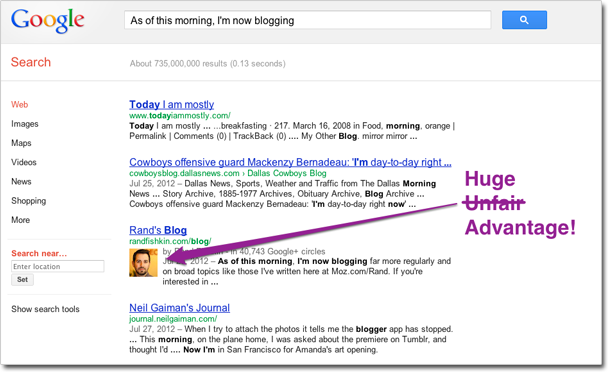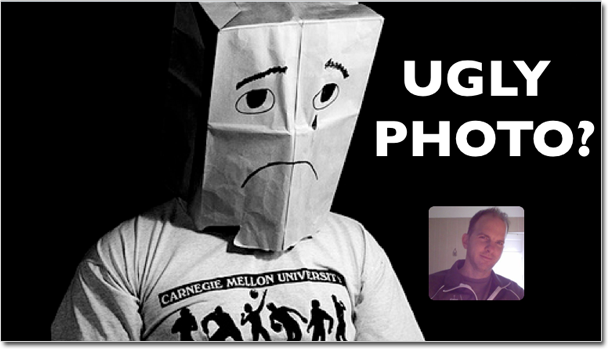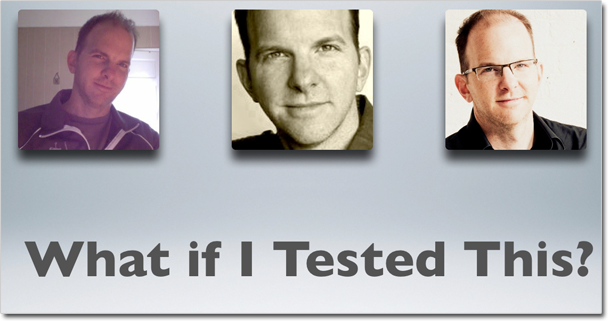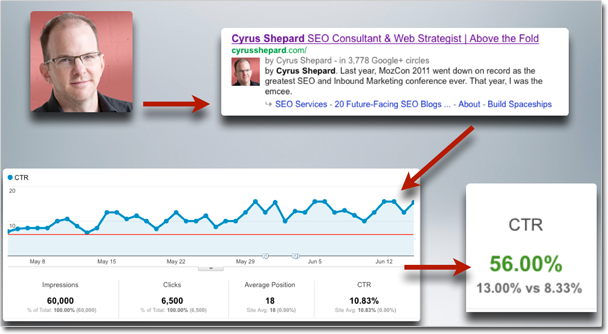
How Optimizing My Ugly Google+ Pic Increased Free Traffic 35%
The following topic was presented at MozCon 2012.
Over the years, SEOs have employed many techniques to control how their site appears in search results. These included:
- Writing compelling Title Tags 65-75 characters long
- Descriptive Meta Descriptions
- Use of NOODP and NOYDIR meta tags
- Keyword rich URLs
By controlling how our snippets appear in search results, we could greatly improve our click-through rates and the amount of free traffic we saw.
But times are changing. For better or worse, Google has now stepped up its title tag rewriting algorithm so that webmasters can no longer predict how their title tags will display. This major bummer that is only compensated by the fact that Google has given us something much better in the form of rich snippets.
In particular, Google+ gave us author profile photos.

This was a huge win. Or so we thought.
After seeing other authors earn the coveted profile pic in Google's search results, I worked for months trying to get my photo to show up. After navigating Google's often confusing markup instructions, my photo finally appeared in search results.
Imagine my disappointment when my traffic stayed flat. I wasn't alone. We even heard stories from webmasters who saw their traffic drop after implementing the author profile markup.
Being lazy, I hadn't considered the actual photo used for the snippet. Unfortunately, I'm not blessed with photogenic looks, especially when the camera is a webcam at 8:30 in the morning.
Time to face facts: my photo was ugly. At the very least, it didn't inspire clicks.

For your author photo, Google pulls the picture directly from your G+ profile, which is easy to change. As an SEO, I thought, "Why don't I test this?"
I dug out better photos and asked a professional photographer/friend to capture me in a more flattering light.

I experimented with different colors and backgrounds. I changed the amount of whitespace visible around my head. I tried glasses and no glasses. (If I owned a wig I would have tested myself with more hair.)
You Could Say I Got a Little Obsessive...

A little Photoshop experience is a dangerous thing.
Yet over time, as I tuned it in, the results started to show a definite improvement in click-through rates.
Use Google Analytics to Track Results
In the Search Engine Optimization report in Google Analytics, you can track click-through rates for all of your impressions in Google's search results. Simply select CTR from the site usage drop-down. You can even use the "Compare to past" feature to compare 2 date ranges.
A word of caution: this is not a scientific experiment. Many factors influence click-through rates, especially rankings. The higher up you are, the more clicks you generally receive. Pay particular attention to the "Average Position" number in the Google Analytics SEO report. With all other things being equal, a change in CTR can easily be attributed to a corresponding change in your profile pic.

The final number settled down around a 35% increase in click-through rate. That's 35% more traffic from Google than what I received before, and it was all free. Imagine how long it would take to gain the same momentum through manual link building.
Another side effect: my engagement metrics improved. Bounce rate dropped while time-on-site and page views increased. It's as if having an authoritative photo in the search results raised users' trust in my site and expectations of authority.
Should You Use a Real Photo? What About Logos?
Google's G+ Content policy regarding photos is pretty slim. It states:
"Your Profile Picture cannot include mature or offensive content. For example, do not use a photo that is a close-up of a person’s buttocks or cleavage."
- http://www.google.com/+/policy/content.html
Ann Smarty, a marketer whom I respect, advises against using logos.
As for offensive photos, there was an issue awhile back with MG Siegler giving G the middle finger, but that's the only instance I know where Google cracked down.
Formula for a Perfect Picture
Is there a magic formula for author profiles? No. You might be tempted to think that changing your background to yellow or red might be the answer, but the right photo depends much more on your audience and content. An author photo for content aimed at a 13-year-old Justin Bieber fan is not the same photo that will perform well with content aimed at retirees searching for tax advice.
When you change your Google+ profile pic, Google displays your new photo very quickly. This makes it easy to run many tests in the course of a couple months. A few final tips include:
- Write killer content
- Implement Authorship Markup
- Put your best face forward
The author's views are entirely their own (excluding the unlikely event of hypnosis) and may not always reflect the views of Moz.



Comments
Please keep your comments TAGFEE by following the community etiquette
Comments are closed. Got a burning question? Head to our Q&A section to start a new conversation.